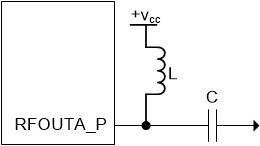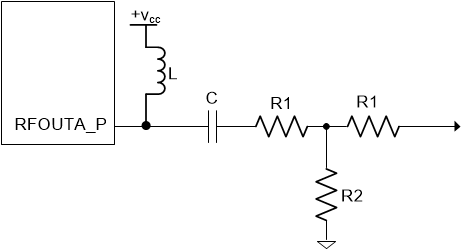SNAS788C November 2019 – March 2022 LMX2694-SEP
PRODUCTION DATA
- 1 Features
- 2 Applications
- 3 Description
- 4 Revision History
- 5 Pin Configuration and Functions
- 6 Specifications
-
7 Detailed Description
- 7.1 Overview
- 7.2 Functional Block Diagram
- 7.3
Feature Description
- 7.3.1 Reference Oscillator Input
- 7.3.2 Reference Path
- 7.3.3 State Machine Clock
- 7.3.4 PLL Phase Detector and Charge Pump
- 7.3.5 N Divider and Fractional Circuitry
- 7.3.6 MUXOUT Pin
- 7.3.7 VCO (Voltage-Controlled Oscillator)
- 7.3.8 Channel Divider
- 7.3.9 Output Buffer
- 7.3.10 Powerdown Modes
- 7.3.11 Treatment of Unused Pins
- 7.3.12 Phase Synchronization
- 7.3.13 Phase Adjust
- 7.3.14 Fine Adjustments for Phase Adjust and Phase SYNC
- 7.3.15 SYSREF
- 7.4 Device Functional Modes
- 7.5 Programming
- 7.6
Register Maps
- 7.6.1 R0 Register (Offset = 0x0) [reset = 0x200C]
- 7.6.2 R1 Register (Offset = 0x1) [reset = 0x80C]
- 7.6.3 R2 Register (Offset = 0x2) [reset = 0x500]
- 7.6.4 R3 Register (Offset = 0x3) [reset = 0x642]
- 7.6.5 R4 Register (Offset = 0x4) [reset = 0xA43]
- 7.6.6 R5 Register (Offset = 0x5) [reset = 0xC8]
- 7.6.7 R6 Register (Offset = 0x6) [reset = 0xC802]
- 7.6.8 R7 Register (Offset = 0x7) [reset = 0xB2]
- 7.6.9 R8 Register (Offset = 0x8) [reset = 0x2000]
- 7.6.10 R9 Register (Offset = 0x9) [reset = 0x604]
- 7.6.11 R10 Register (Offset = 0xA) [reset = 0x10F8]
- 7.6.12 R11 Register (Offset = 0xB) [reset = 0x18]
- 7.6.13 R12 Register (Offset = 0xC) [reset = 0x5001]
- 7.6.14 R13 Register (Offset = 0xD) [reset = 0x4000]
- 7.6.15 R14 Register (Offset = 0xE) [reset = 0x1E70]
- 7.6.16 R15 Register (Offset = 0xF) [reset = 0x64F]
- 7.6.17 R16 Register (Offset = 0x10) [reset = 0x80]
- 7.6.18 R17 Register (Offset = 0x11) [reset = 0x96]
- 7.6.19 R18 Register (Offset = 0x12) [reset = 0x64]
- 7.6.20 R19 Register (Offset = 0x13) [reset = 0x27B7]
- 7.6.21 R20 Register (Offset = 0x14) [reset = 0x3048]
- 7.6.22 R21 Register (Offset = 0x15) [reset = 0x401]
- 7.6.23 R22 Register (Offset = 0x16) [reset = 0x1]
- 7.6.24 R23 Register (Offset = 0x17) [reset = 0x7C]
- 7.6.25 R24 Register (Offset = 0x18) [reset = 0x71A]
- 7.6.26 R25 Register (Offset = 0x19) [reset = 0x624]
- 7.6.27 R26 Register (Offset = 0x1A) [reset = 0xDB0]
- 7.6.28 R27 Register (Offset = 0x1B) [reset = 0x2]
- 7.6.29 R28 Register (Offset = 0x1C) [reset = 0x488]
- 7.6.30 R29 Register (Offset = 0x1D) [reset = 0x318C]
- 7.6.31 R30 Register (Offset = 0x1E) [reset = 0x318C]
- 7.6.32 R31 Register (Offset = 0x1F) [reset = 0xC3EC]
- 7.6.33 R32 Register (Offset = 0x20) [reset = 0x393]
- 7.6.34 R33 Register (Offset = 0x21) [reset = 0x1E21]
- 7.6.35 R34 Register (Offset = 0x22) [reset = 0x10]
- 7.6.36 R35 Register (Offset = 0x23) [reset = 0x4]
- 7.6.37 R36 Register (Offset = 0x24) [reset = 0x70]
- 7.6.38 R37 Register (Offset = 0x25) [reset = 0x205]
- 7.6.39 R38 Register (Offset = 0x26) [reset = 0xFFFF]
- 7.6.40 R39 Register (Offset = 0x27) [reset = 0xFFFF]
- 7.6.41 R40 Register (Offset = 0x28) [reset = 0x0]
- 7.6.42 R41 Register (Offset = 0x29) [reset = 0x0]
- 7.6.43 R42 Register (Offset = 0x2A) [reset = 0x0]
- 7.6.44 R43 Register (Offset = 0x2B) [reset = 0x0]
- 7.6.45 R44 Register (Offset = 0x2C) [reset = 0x22A2]
- 7.6.46 R45 Register (Offset = 0x2D) [reset = 0xC622]
- 7.6.47 R46 Register (Offset = 0x2E) [reset = 0x7F0]
- 7.6.48 R47 Register (Offset = 0x2F) [reset = 0x300]
- 7.6.49 R48 Register (Offset = 0x30) [reset = 0x3E0]
- 7.6.50 R49 Register (Offset = 0x31) [reset = 0x4180]
- 7.6.51 R50 Register (Offset = 0x32) [reset = 0x80]
- 7.6.52 R51 Register (Offset = 0x33) [reset = 0x80]
- 7.6.53 R52 Register (Offset = 0x34) [reset = 0x420]
- 7.6.54 R53 Register (Offset = 0x35) [reset = 0x0]
- 7.6.55 R54 Register (Offset = 0x36) [reset = 0x0]
- 7.6.56 R55 Register (Offset = 0x37) [reset = 0x0]
- 7.6.57 R56 Register (Offset = 0x38) [reset = 0x0]
- 7.6.58 R57 Register (Offset = 0x39) [reset = 0x0]
- 7.6.59 R58 Register (Offset = 0x3A) [reset = 0x8001]
- 7.6.60 R59 Register (Offset = 0x3B) [reset = 0x1]
- 7.6.61 R60 Register (Offset = 0x3C) [reset = 0x3E8]
- 7.6.62 R61 Register (Offset = 0x3D) [reset = 0xA8]
- 7.6.63 R62 Register (Offset = 0x3E) [reset = 0xAE]
- 7.6.64 R63 Register (Offset = 0x3F) [reset = 0x0]
- 7.6.65 R64 Register (Offset = 0x40) [reset = 0x1388]
- 7.6.66 R65 Register (Offset = 0x41) [reset = 0x0]
- 7.6.67 R66 Register (Offset = 0x42) [reset = 0x140]
- 7.6.68 R67 Register (Offset = 0x43) [reset = 0x0]
- 7.6.69 R68 Register (Offset = 0x44) [reset = 0x3E8]
- 7.6.70 R69 Register (Offset = 0x45) [reset = 0x0]
- 7.6.71 R70 Register (Offset = 0x46) [reset = 0xC350]
- 7.6.72 R71 Register (Offset = 0x47) [reset = 0x80]
- 7.6.73 R72 Register (Offset = 0x48) [reset = 0x1]
- 7.6.74 R73 Register (Offset = 0x49) [reset = 0x3F]
- 7.6.75 R74 Register (Offset = 0x4A) [reset = 0x0]
- 7.6.76 R75 Register (Offset = 0x4B) [reset = 0x800]
- 7.6.77 R76 Register (Offset = 0x4C) [reset = 0xC]
- 7.6.78 R77 Register (Offset = 0x4D) [reset = 0x0]
- 7.6.79 R78 Register (Offset = 0x4E) [reset = 0x64]
- 7.6.80 R79 Register (Offset = 0x4F) [reset = 0x0]
- 7.6.81 R80 Register (Offset = 0x50) [reset = 0x0]
- 7.6.82 R81 Register (Offset = 0x51) [reset = 0x0]
- 7.6.83 R82 Register (Offset = 0x52) [reset = 0x0]
- 7.6.84 R83 Register (Offset = 0x53) [reset = 0x0]
- 7.6.85 R84 Register (Offset = 0x54) [reset = 0x0]
- 7.6.86 R85 Register (Offset = 0x55) [reset = 0x0]
- 7.6.87 R86 Register (Offset = 0x56) [reset = 0x0]
- 7.6.88 R87 Register (Offset = 0x57) [reset = 0x0]
- 7.6.89 R88 Register (Offset = 0x58) [reset = 0x0]
- 7.6.90 R89 Register (Offset = 0x59) [reset = 0x0]
- 7.6.91 R90 Register (Offset = 0x5A) [reset = 0x0]
- 7.6.92 R91 Register (Offset = 0x5B) [reset = 0x0]
- 7.6.93 R92 Register (Offset = 0x5C) [reset = 0x0]
- 7.6.94 R93 Register (Offset = 0x5D) [reset = 0x0]
- 7.6.95 R94 Register (Offset = 0x5E) [reset = 0x0]
- 7.6.96 R95 Register (Offset = 0x5F) [reset = 0x0]
- 7.6.97 R96 Register (Offset = 0x60) [reset = 0x0]
- 7.6.98 R97 Register (Offset = 0x61) [reset = 0x0]
- 7.6.99 R98 Register (Offset = 0x62) [reset = 0x0]
- 7.6.100 R99 Register (Offset = 0x63) [reset = 0x0]
- 7.6.101 R100 Register (Offset = 0x64) [reset = 0x0]
- 7.6.102 R101 Register (Offset = 0x65) [reset = 0x0]
- 7.6.103 R102 Register (Offset = 0x66) [reset = 0x0]
- 7.6.104 R103 Register (Offset = 0x67) [reset = 0x0]
- 7.6.105 R104 Register (Offset = 0x68) [reset = 0x0]
- 7.6.106 R105 Register (Offset = 0x69) [reset = 0x440]
- 7.6.107 R106 Register (Offset = 0x6A) [reset = 0x7]
- 7.6.108 R107 Register (Offset = 0x6B) [reset = 0x0]
- 7.6.109 R108 Register (Offset = 0x6C) [reset = 0x0]
- 7.6.110 R109 Register (Offset = 0x6D) [reset = 0x0]
- 7.6.111 R110 Register (Offset = 0x6E) [reset = 0x0]
- 7.6.112 R111 Register (Offset = 0x6F) [reset = 0x0]
- 7.6.113 R112 Register (Offset = 0x70) [reset = 0x0]
- 7.6.114 R113 Register (Offset = 0x71) [reset = 0x0]
- 7.6.115 R114 Register (Offset = 0x72) [reset = 0x0]
- 8 Application and Implementation
- 9 Power Supply Recommendations
- 10Layout
- 11Device and Documentation Support
- 12Mechanical, Packaging, and Orderable Information
Package Options
Refer to the PDF data sheet for device specific package drawings
Mechanical Data (Package|Pins)
- RTC|48
Thermal pad, mechanical data (Package|Pins)
Orderable Information
8.1.4.2 Inductor Pullup
Another strategy is to choose an inductor pullup (L). This allows a higher impedance without any concern of creating any DC drop across the component. Ideally, the inductor should be chosen large enough so that the impedance is high relative to the load impedance and also be operating away from its self-resonant frequency. For instance, consider a 3.3-nH pullup inductor with a self-resonant frequency of 7 GHz driving a 25-Ω spectrum analyzer input. This inductor theoretically has j50-Ω input impedance around 2.4 GHz. At this frequency, this in parallel with load is about j35-Ω, which is a 3-dB power reduction. At 1.4 GHz, this inductor has impedance of about 29 Ω. This in parallel with the 50-Ω load has a magnitude of 25 Ω, which is the same result seen with the 50-Ω pullup. The main issue with the inductor pullup is that the impedance does not look nicely matched to the load.
 Figure 8-3 Inductor Pullup
Figure 8-3 Inductor PullupAs the output impedance is not so nicely matched, but there is higher output power, it makes sense to use a resistive pad to get the best impedance control. A 6-dB pad (R1 = 18 Ω, R2 = 68 Ω) is likely more attenuation than necessary. A 3-dB or even 1-dB pad might suffice. Two AC-coupling capacitors are required before the pad. In Figure 8-4, one of them is placed by the resistor to ground to minimize the number of components in the high frequency path for lower loss.
 Figure 8-4 Inductor Pullup With Pad
Figure 8-4 Inductor Pullup With PadFor the resistive pad, Table 8-2 shows some common values:
| ATTENUATION | R1 | R2 |
|---|---|---|
| 1 dB | 2.7 Ω | 420 Ω |
| 2 dB | 5.6 Ω | 220 Ω |
| 3 dB | 6.8 Ω | 150 Ω |
| 4 dB | 12 Ω | 100 Ω |
| 5 dB | 15 Ω | 82 Ω |
| 6 dB | 18 Ω | 68 Ω |